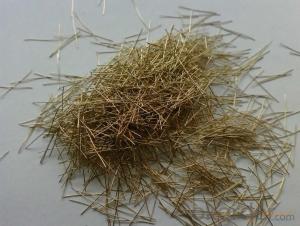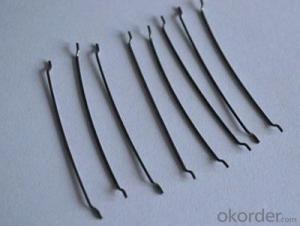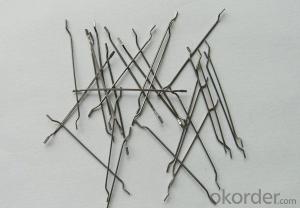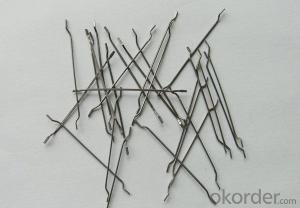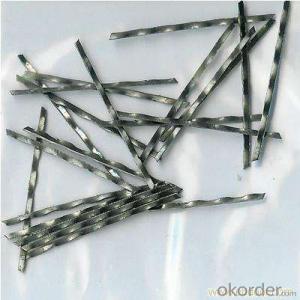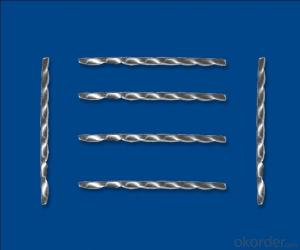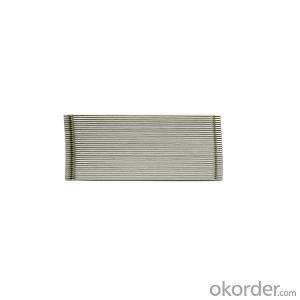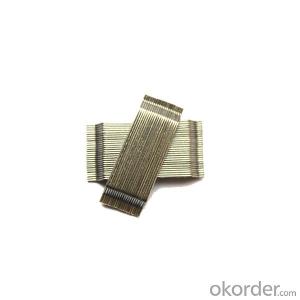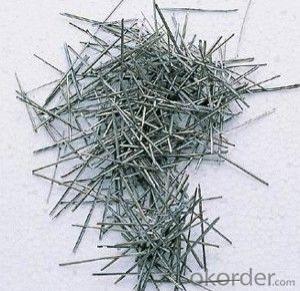Steel Fiber Copper Coated Company From China CNBM International
- Loading Port:
- Tianjin
- Payment Terms:
- TT OR LC
- Min Order Qty:
- 1000 kg
- Supply Capability:
- 30000 kg/month
OKorder Service Pledge
OKorder Financial Service
You Might Also Like
Quick Details
| Place of Origin: | Hebei, China (Mainland) | Brand Name: | cnbm | Model Number: | CW04 |
| Material: | Steel | Material:: | Steel,low carbon steel wire | Standard:: | ASTM ,ISO9001,CE |
| Shape:: | hooked ends and straight middle | Grade:: | Q195 | Application:: | shortcrete on tunnel, underground project, dam plate |
| Tensile strength:: | 2850Mpa | Demension:: | per your requirement | Place of Origin:: | HeBei China (Mainland) |
| Brand Name:: | ZhiTai steel fiber | Delivery Detail:: | in 7 days upon receive prepayment |
Specifications
Steel fiber for Concrete Reinforcement
1.High tensile strength 2.Length 6-10mm 3.Diameter 0.15-0.3mm
Copper coated steel fiber
1. diameter: 0.15-0.3mm
2. lengthe: 6-10mm
3. high tensile strength : 2850Mpa
4. It is widely used for concrete reinforcement.
Picture
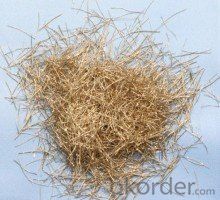
Steel fiber
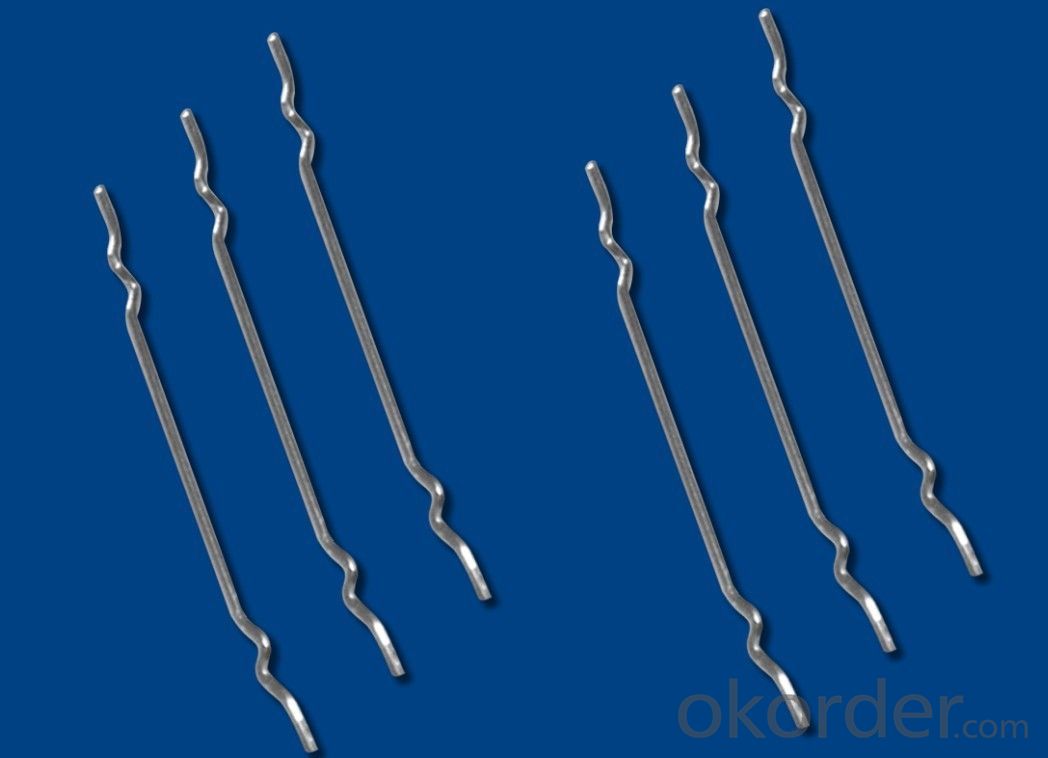
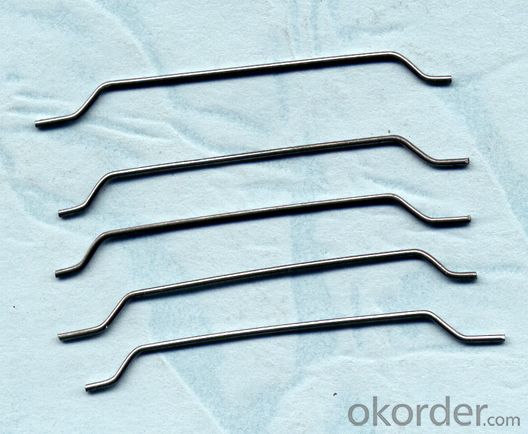
FAQ
certificated: ISO 9001
Technical advantages of Daye steel fiber:
A. Improve mechanical performance of concrete
B. Provide uniform distribution throughout concrete with excellent mixing
C. No balling or caking by adopt correct mixing method
D. Reduce concrete volume
E.Save construction time and cost
F.Reduce excavation volume
G.Available for jointless floor.
- Q:Can melt extract stainless steel fiber be used in railway sleepers?
- Certainly, melt extract stainless steel fiber is applicable for utilization in railway sleepers. Known for its exceptional resistance to corrosion and fatigue, stainless steel fiber serves as a robust material. By incorporating it into railway sleepers, the overall strength and longevity of the sleepers are significantly enhanced, rendering them suitable for heavy train loads and extended service life. The melt extract process guarantees the uniform and consistent shape of the stainless steel fibers, thereby further augmenting their performance and dependability. Moreover, the utilization of stainless steel fiber aids in the prevention of crack formation and improves resistance to thermal expansion and contraction, making it an ideal selection for railway sleepers.
- Q:How does the addition of melt extract stainless steel fiber affect the fresh concrete properties?
- The addition of melt extract stainless steel fiber to fresh concrete can significantly enhance its properties. It improves the concrete's toughness, durability, and resistance against cracking, impact, and abrasion. The fibers act as reinforcement, dispersing stress throughout the concrete matrix, resulting in improved structural performance. Additionally, the stainless steel fibers can also improve the concrete's resistance to corrosion, making it suitable for various applications in harsh environments.
- Q:How does melt extract stainless steel fiber contribute to the fatigue behavior of concrete?
- Melt extract stainless steel fiber plays a significant role in enhancing the fatigue behavior of concrete. The addition of these fibers in the concrete mix improves its resistance to cracking and increases its durability, particularly under cyclic loading conditions. One of the main ways in which melt extract stainless steel fiber contributes to the fatigue behavior of concrete is by reducing the propagation of microcracks. As concrete is subjected to repeated loading and unloading cycles, microcracks begin to form and propagate, leading to eventual failure. However, the presence of stainless steel fibers acts as a reinforcement, effectively bridging these microcracks and preventing their further propagation. This improves the overall fatigue resistance of the concrete and extends its service life. Moreover, melt extract stainless steel fibers also enhance the tensile strength and ductility of concrete. Concrete is known for its low tensile strength, and the inclusion of fibers helps to overcome this weakness. The fibers distribute the applied load more evenly throughout the concrete matrix, reducing stress concentrations and enhancing its ability to withstand cyclic loading. This, in turn, leads to improved fatigue behavior. Additionally, the use of melt extract stainless steel fibers in concrete can also improve its resistance to corrosion. Stainless steel is inherently resistant to corrosion, and when incorporated into the concrete mix, it acts as a protective barrier against the ingress of aggressive substances such as chlorides and sulfates. This helps to prevent corrosion of the reinforcing steel within the concrete, which can weaken its structural integrity and lead to premature failure. In conclusion, melt extract stainless steel fiber greatly contributes to the fatigue behavior of concrete by reducing microcrack propagation, increasing tensile strength and ductility, and improving resistance to corrosion. These benefits enhance the overall durability and lifespan of concrete structures, making them more reliable and cost-effective in the long run.
- Q:What is the typical aspect ratio of melt extract stainless steel fibers?
- The typical aspect ratio of melt extract stainless steel fibers is usually between 20:1 to 100:1.
- Q:Can melt extract stainless steel fiber be used in earthquake-resistant concrete structures?
- Certainly, earthquake-resistant concrete structures can utilize melt extract stainless steel fiber. Renowned for their exceptional ductility and high tensile strength, stainless steel fibers are an ideal choice for bolstering the toughness and durability of concrete. The inclusion of these fibers in concrete enhances its ability to withstand cracking, shrinkage, and spalling during seismic events. The utilization of stainless steel fibers in earthquake-resistant concrete structures plays a crucial role in mitigating the adverse effects of earthquakes. Acting as reinforcement, these fibers augment the concrete's strength and hinder the propagation of cracks. This reinforcement fortifies the overall structural integrity of the concrete, rendering it more resistant to the dynamic forces unleashed by earthquakes. Furthermore, melt extract stainless steel fibers possess a high melting point, corrosion resistance, and exceptional thermal stability. These attributes render them suitable for long-term implementation in hostile environments, such as earthquake-prone regions. These fibers remain intact over time, ensuring the concrete structure's long-lasting durability and efficacy. Additionally, melt extract stainless steel fibers have undergone rigorous testing and have been proven to enhance the seismic performance of concrete structures. They conform to various international standards, such as ASTM and ACI, guaranteeing their quality and reliability. These fibers have successfully been employed in a diverse array of earthquake-resistant applications, including bridges, tunnels, high-rise buildings, and industrial structures. In conclusion, melt extract stainless steel fiber can indeed be employed in earthquake-resistant concrete structures. Its exceptional tensile strength, ductility, and resistance to cracking make it an outstanding reinforcement material for fortifying the durability and seismic performance of concrete. By incorporating stainless steel fibers into concrete, engineers can effectively bolster the resistance of structures to seismic forces, ensuring the safety and longevity of infrastructure in earthquake-prone regions.
- Q:Can melt extract stainless steel fiber be used in the construction of power plant structures?
- Certainly, the utilization of melt extract stainless steel fiber is possible in the construction of power plant structures. In construction applications, stainless steel fibers offer numerous benefits, such as their exceptional strength, resistance to corrosion, and long-lasting nature. In power plants, where structures are subjected to elevated temperatures, extreme pressures, and harsh environments, stainless steel fibers can serve as an additional reinforcement to concrete or other construction materials. The presence of stainless steel fibers aids in enhancing the structural integrity of power plant structures by bolstering the concrete's ability to withstand cracking, spalling, and thermal shock. They effectively mitigate shrinkage and minimize crack formation, thus ensuring the durability and safety of power plant facilities. Furthermore, melt extract stainless steel fibers possess remarkable thermal conductivity, enabling them to efficiently disperse heat and prevent localized hot spots within construction materials. This characteristic is particularly crucial in power plants, where excessive heat can lead to structural harm and compromise the overall performance of the facility. Moreover, stainless steel fibers are non-magnetic, rendering them suitable for use in power plants that necessitate non-magnetic materials due to specific equipment or operational requirements. To conclude, the employment of melt extract stainless steel fibers is indeed feasible in the construction of power plant structures. Their exceptional strength, corrosion resistance, durability, and thermal conductivity make them an invaluable addition in guaranteeing the structural integrity and longevity of power plant facilities.
- Q:What is the effect of melt extract stainless steel fiber on the shear strength of concrete beams?
- The impact of melt extract stainless steel fiber on the shear strength of concrete beams generally yields positive results. When incorporated into concrete, stainless steel fibers act as reinforcement by enhancing both tensile and flexural strength. This reinforcement mechanism effectively prevents crack propagation and enhances the concrete's ductility and toughness. Regarding shear strength, the inclusion of melt extract stainless steel fibers in concrete beams significantly boosts their resistance against shear forces. These fibers improve the cohesion between the concrete matrix and aggregates, resulting in enhanced interlocking and shear transfer mechanisms. Consequently, the concrete beams exhibit increased resistance to shear failure and overall structural integrity. Furthermore, the presence of stainless steel fibers minimizes the formation and propagation of microcracks caused by shear stresses in the concrete. By limiting crack formation, the fibers contribute to maintaining the continuity and stability of the concrete beams, thereby enhancing their shear strength. In addition, the aspect ratio (length to diameter ratio) of the stainless steel fibers plays a vital role in their impact on shear strength. Longer fibers with higher aspect ratios offer superior reinforcement and improve the shear strength of concrete beams compared to shorter fibers. It is crucial to carefully determine the optimal dosage and distribution of stainless steel fibers based on the specific requirements and design considerations of the concrete beams. Factors such as fiber length, diameter, volume fraction, and concrete mix proportions should be taken into account to achieve the desired improvement in shear strength while ensuring the overall performance and durability of the concrete structure.
- Q:Can melt extract stainless steel fiber be used in the construction of water storage tanks?
- Melt extract stainless steel fiber is a suitable material for the construction of water storage tanks. Its characteristics include high strength, durability, and corrosion resistance, which make it ideal for storing water. The fiber can endure the challenging conditions and chemicals commonly present in water tanks, guaranteeing prolonged functionality and reducing the chances of leaks or deterioration. Furthermore, the inclusion of stainless steel fiber improves the tank's structural integrity, reinforcing it and preventing cracks or failures. Ultimately, employing melt extract stainless steel fiber in water storage tank construction is a dependable and efficient option.
- Q:What is the effect of melt extract stainless steel fiber on the creep of concrete?
- The effect of melt extract stainless steel fiber on the creep of concrete is that it reduces the overall creep deformation of the concrete. This is due to the high tensile strength and ductility of stainless steel fiber, which helps to distribute and resist the applied load more effectively. Additionally, the inclusion of stainless steel fiber enhances the overall crack resistance of concrete, thereby reducing the potential for creep deformation.
- Q:How does melt extract stainless steel fiber affect the shrinkage of concrete?
- Melt extract stainless steel fiber can significantly reduce the shrinkage of concrete. The fibers act as reinforcement within the concrete matrix, restraining the movement and cracking caused by shrinkage. This results in a more durable and crack-resistant concrete structure.
1. Manufacturer Overview |
|
|---|---|
| Location | |
| Year Established | |
| Annual Output Value | |
| Main Markets | |
| Company Certifications | |
2. Manufacturer Certificates |
|
|---|---|
| a) Certification Name | |
| Range | |
| Reference | |
| Validity Period | |
3. Manufacturer Capability |
|
|---|---|
| a)Trade Capacity | |
| Nearest Port | |
| Export Percentage | |
| No.of Employees in Trade Department | |
| Language Spoken: | |
| b)Factory Information | |
| Factory Size: | |
| No. of Production Lines | |
| Contract Manufacturing | |
| Product Price Range | |
Send your message to us
Steel Fiber Copper Coated Company From China CNBM International
- Loading Port:
- Tianjin
- Payment Terms:
- TT OR LC
- Min Order Qty:
- 1000 kg
- Supply Capability:
- 30000 kg/month
OKorder Service Pledge
OKorder Financial Service
Similar products
New products
Hot products
Hot Searches
Related keywords
